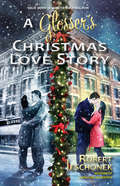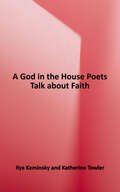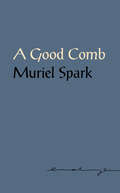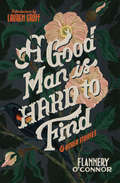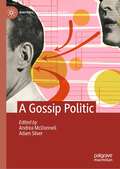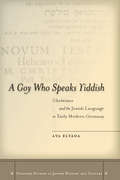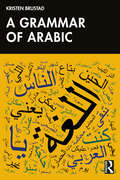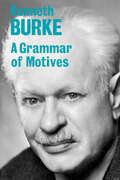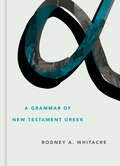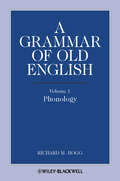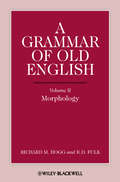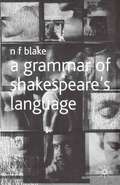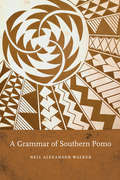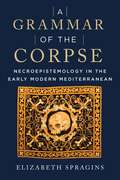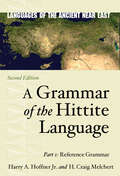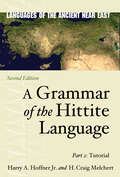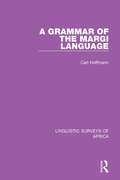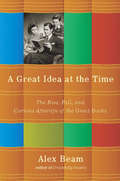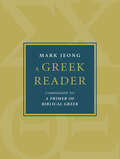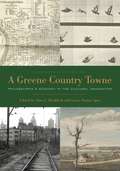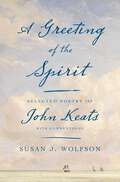- Table View
- List View
A Glosser's Christmas Love Story
by Robert Jeschonek Ben BaldwinWith her fiancé far away fighting a war in Korea, Sarah faces a blue Christmas in Johnstown, Pennsylvania in 1953. But going to work as an elf at Glosser’s Department Store turns her holiday upside-down. Santa Claus, played by fellow employee Frank, falls beard over sleighbells for her. When the magic of the season at Glosser’s lights a spark of romance between them, Sarah is torn between the man at war and the one in the St. Nick outfit. On the night before Christmas, she must make a fateful choice that changes everything...and leads her to a crossroads 63 years later at the famous musical Christmas tree in Johnstown’s Central Park. Don't miss this sweet holiday romance by the author of LONG LIVE GLOSSER'S and PENN TRAFFIC FOREVER.
A God in the House: Poets Talk about Faith
by Ilya Kaminsky Katherine TowlerLiterary Nonfiction. Poetry. Editors Ilya Kaminsky and Katherine Towler have gathered conversations with nineteen of America's leading poets, reflecting upon their diverse experiences with spirituality and the craft of writing. Bringing together poets who are Christian, Buddhist, Jewish, Muslim, Pagan, Native American, Wiccan, agnostic, and otherwise, this book offers frank and thoughtful consideration of themes too often polarized and politicized in our society. Participants include Li-Young Lee, Jane Hirshfield, Carolyn Forché, Gerald Stern, Christian Wiman, Joy Harjo, and Gregory Orr, and others, all wrestling with difficult questions of human existence and the sources of art.
A Good Cause (Reach Into Phonics Ser.)
by Nonie K. Lesaux National Geographic Learning Sylvia Linan ThompsonNIMAC-sourced textbook
A Good Comb: The Sayings of Muriel Spark
by Muriel SparkCelebrate the immortal Muriel Spark’s hundredth birthday by imbibing a delicious glass of her bubbly wit A Good Comb, a small gift edition of Muriel Spark’s brilliant asides, sayings, and aphorisms, is a book for sheer enjoyment. No writer offers such lively, pointed, puckish insights: “Neurotics are awfully quick to notice other people’s mentalities.” “It is impossible to persuade a man who does not disagree, but smiles.” “The sacrifice of pleasure is of course itself a pleasure.” “It is impossible to repent of love. The sin of love does not exist.” “She wasn’t a person to whom things happen.” “You look for one thing and you find another.” “It calms you down, a good comb.” Her scope is great and her striking insights are precise and unforgettable. This book will entertain you—it will even help you live your life. Drink in the pleasures of this little volume along with the benefits of taking up such advice as “Never make excuses but if you must, never make more than one—it gives the appearance of insincerity.” And “Beware of men bearing flowers.”
A Good Man Is Hard to Find and Other Stories: And Other Stories
by Flannery O'ConnorThe collection that established O'Connor's reputation as one of the american masters of the short story. <P><P>The volume contains the celebrated title story, a tale of the murderous fugitive The Misfit, as well as "The Displaced Person" and eight other stories.
A Gossip Politic (Rhetoric, Politics and Society)
by Adam Silver Andrea McDonnellThis book makes explicit the historical, technological, and discursive links between gossip as a mode of communication, news media, and contemporary politics. A Gossip Politic advances a new framework of gossip, applying the informal understanding of the term to news talk and political actors. Authored by esteemed scholars in the fields of Political Science, Media Studies, Linguistics, and Sociology, chapters consider the influence of gossip on the press, the American presidency, and the public. A Gossip Politic provides readers with a multi-faceted portrait of the ways in which gossip has influenced media history, shaped our understanding of democracy, and contributed to our current political landscape.
A Goy Who Speaks Yiddish: Christians and the Jewish Language in Early Modern Germany
by Aya ElyadaThis book explores the unique phenomenon of Christian engagement with Yiddish language and literature from the beginning of the sixteenth century to the late eighteenth century. By exploring the motivations for Christian interest in Yiddish, and the differing ways in which Yiddish was discussed and treated in Christian texts,A Goy Who Speaks Yiddishaddresses a wide array of issues, most notably Christian Hebraism, Protestant theology, early modern Yiddish culture, and the social and cultural history of language in early modern Europe. Elyada's analysis of a wide range of philological and theological works, as well as textbooks, dictionaries, ethnographical writings, and translations, demonstrates that Christian Yiddishism had implications beyond its purely linguistic and philological dimensions. Indeed, Christian texts on Yiddish reveal not only the ways in which Christians perceived and defined Jews and Judaism, but also, in a contrasting vein, how they viewed their own language, religion, and culture.
A Grammar Of Tariana, From Northwest Amazonia
by Alexandra Y. AikhenvaldThis is a comprehensive reference grammar of Tariana, an endangered Arawak language from a remote region in the northwest Amazonian jungle. Its speakers traditionally marry someone speaking a different language, and as a result most people are fluent in five or six languages. Because of this rampant multilingualism, Tariana combines a number of features inherited from the protolanguage with properties diffused from neighbouring but unrelated Tucanoan languages. Typologically unusual features of the language include: an array of classifiers independent of genders, complex serial verbs, case marking depending on the topicality of a noun, and double marking of case and of number. Tariana has obligatory evidentiality: every sentence contains a special element indicating whether the information was seen, heard, or inferred by the speaker, or whether the speaker acquired it from somebody else. This grammar will be a valuable source-book for linguists and others interested in natural languages.
A Grammar of Arabic
by Kristen BrustadA Grammar of Arabic models a new framework for studying varieties of Arabic comparatively, highlighting the patterns of variation and consistency, and showing how different styles, from primarily spoken and casual to primarily written and formal, are linguistically interrelated.This non-traditional reference grammar is structured around patterns of usage rather than prescriptive rules, aligning function with form and taking advantage of general principles of language. Using data from Classical Arabic, Arabic, Modern Standard Arabic, and dialects spoken in Morocco, Egypt, Sudan, the Levant, Iraq, and the Arabian Gulf, this grammar examines the actual usage of these language varieties, broadening understanding of Arabic dialects from a linguistics perspective while also giving readers the ability to engage language diversity.Designed for instructors, researchers, and advanced students of Arabic, A Grammar of Arabic explores Arabic from an internally comparative perspective that will also be valuable to theoretical linguists.
A Grammar of Motives
by Kenneth BurkeAbout this book Mr. Burke contributes an introductory and summarizing remark, "What is involved, when we say what people are doing and why they are doing it? An answer to that question is the subject of this book. The book is concerned with the basic forms of thought which, in accordance with the nature of the world as all men necessarily experience it, are exemplified in the attributing of motives. These forms of thought can be embodied profoundly or trivially, truthfully or falsely. They are equally present in systematically elaborated or metaphysical structures, in legal judgments, in poetry and fiction, in political and scientific works, in news and in bits of gossip offered at random."
A Grammar of New Testament Greek (Eerdmans Language Resources)
by Rodney A. WhitacreA reader&’s guide to the morphology and syntax of Koine Greek From the pen of a seasoned instructor of biblical Greek, this book functions as both an essential resource for second-year students and an invaluable asset for all readers as they continue to hone and deepen their linguistic skills. It begins with a basic overview of the language for new learners and for those looking for a brief refresher before moving into nuanced matters of morphology and syntax. Whitacre&’s aim is ultimately to help readers understand the subtleties of the language on the pages of the New Testament; thus, he engages with the biblical text both grammatically and exegetically, so that readers can experience its full power and beauty. Including numerous illustrative examples throughout and several useful appendices at the end, A Grammar of New Testament Greek is indispensable both as a textbook and as a reference for all readers of the Greek New Testament—and other texts written in Koine, such as the Septuagint and the Apostolic Fathers.
A Grammar of Old English, Volume 1: Phonology
by Richard M. HoggFirst published in 1992, A Grammar of Old English, Volume 1: Phonology was a landmark publication that in the intervening years has not been surpassed in its depth of scholarship and usefulness to the field. With the 2011 posthumous publication of Richard M. Hogg’s Volume 2: Morphology, Volume 1 is again in print, now in paperback, so that scholars can own this complete work. Takes account of major developments both in the field of Old English studies and in linguistic theory Takes full advantage of the Dictionary of Old English project at Toronto, and includes full cross-references to the DOE data Fully utilizes work in phonemic and generative theory and related topics Provides material crucial for future research both in diachronic and synchronic phonology and in historical sociolinguistics
A Grammar of Old English, Volume 2: Morphology
by Richard M. Hogg R. D. FulkA Grammar of Old English, Volume II: Morphology completes Richard M. Hogg's two-volume analysis of the sounds and grammatical forms of the Old English language. Incorporates insights derived from the latest theoretical and technological advances, which post-date most Old English grammars Utilizes the databases of the Toronto Dictionary of Old English project - a digital corpus comprising at least one copy of each text surviving in Old English Features separation of diachronic and synchronic considerations in the sometimes complicated analysis of Old English noun morphology Includes extensive bibliographical coverage of Old English morphology
A Grammar of Patwin (Studies in the Native Languages of the Americas)
by Lewis C. LawyerPublished through the Recovering Languages and Literacies of the Americas initiative, supported by the Andrew W. Mellon Foundation. A Native American language formerly spoken in hundreds of communities in the interior of California, Patwin (also known as Wintun Tʼewe) is now spoken by a small but growing number of language revitalizationists and their students. A Grammar of Patwin brings together two hundred years of word lists, notebooks, audio recordings, and manuscripts from archives across the United States and synthesizes this scattered collection into the first published description of the Patwin language. This book shines a light on the knowledge of past speakers and researchers with a clear and well-organized description supported by ample archival evidence. Lewis C. Lawyer addresses the full range of grammatical structure with chapters on phonetics, phonology, nominals, nominal modifiers, spatial terms, verbs, and clauses. At every level of grammatical structure there is notable variation between dialects, and this variation is painstakingly described. An introductory chapter situates the language geographically and historically and also gives a detailed account of previous work on the language and of the archival materials on which the study is based. Throughout the process of writing this book, Lawyer remained in contact with Patwin communities and individuals, who helped to ensure that the content is appropriate from a cultural perspective.
A Grammar of Shakespeare’s Language
by N. F. BlakeWhen you read Shakespeare or watch a performance of one of his plays, do you find yourself wondering what it was he actually meant? Do you consult modern editions of Shakespeare's plays only to find that your questions still remain unanswered? A Grammar of Shakespeare's Language, the first comprehensive grammar of Shakespeare's language for over one hundred years, will help you find out exactly what Shakespeare meant. Steering clear of linguistic jargon, Professor Blake provides a detailed analysis of Shakespeare's language. He includes accounts of the morphology and syntax of different parts of speech, as well as highlighting features such as concord, negation, repetition and ellipsis. He treats not only traditional features such as the make-up of clauses, but also how language is used in various forms of conversational exchange, such as forms of address, discourse markers, greetings and farewells. This book will help you to understand much that may have previously seemed difficult or incomprehensible, thus enhancing your enjoyment of his plays.
A Grammar of Southern Pomo
by Neil Alexander WalkerA title in the Recovering Languages and Literacies of the Americas initiative, supported by the Andrew W. Mellon Foundation.A Grammar of Southern Pomo is the first comprehensive description of the Southern Pomo language, which lost its last fluent speaker in 2014. Southern Pomo is one of seven Pomoan languages once spoken in the vicinity of Clear Lake and the Russian River drainage of California. Prior to European contact, a third of all Pomoan peoples spoke Southern Pomo, and descendants of these speakers are scattered across several present-day reservations. These descendants have recently initiated efforts to revitalize the language. The unique culture of Southern Pomo speakers is embedded in the language in several ways. There are separate words for the many different species of oak trees and their different acorns, which were the people&’s staple cuisine. The kinship system is unusually rich both semantically and morphologically, with terms marked for possession, generation, number, and case. Verbs similarly encode the ancient interactions of speakers with their land in more than a dozen directional suffixes indicating specific paths of movement.A Grammar of Southern Pomo sheds new light on a relatively unknown Indigenous California speech community. In many instances Neil Alexander Walker discusses phenomena that are rare or entirely unattested outside the language and challenges long-standing ideas about what human speech communities can create and pass on to children as well as the degree to which culture and place are inextricably woven into language.
A Grammar of the Corpse: Necroepistemology in the Early Modern Mediterranean
by Elizabeth SpraginsNo matter when or where one starts telling the story of the battle of al-Qasr al-Kabir (August 4, 1578), the precipitating event for the formation of the Iberian Union, one always stumbles across dead bodies—rotting in the sun on abandoned battlefields, publicly displayed in marketplaces, exhumed and transported for political uses. A Grammar of the Corpse: Necroepistemology in the Early Modern Mediterranean proposes an approach to understanding how dead bodies anchored the construction of knowledge within early modern Mediterranean historiography.A Grammar of the Corpse argues that the presence of the corpse in historical narrative is not incidental. It fills a central gap in testimonial narrative: providing tangible evidence of the narrator’s reliability while provoking an affective response in the audience. The use of corpses as a source of narrative authority mobilizes what cultural historians, philosophers, and social anthropologists have pointed to as the latent power of the dead for generating social and political meaning and knowledge. A Grammar of the Corpse analyzes the literary, semiotic, and epistemological function these bodies serve within text and through language. It finds that corpses are indexically present and yet disturbingly absent, a tension that informs their fraught relationship to their narrators’ own bodies and makes them useful but subversive tools of communication and knowledge.A Grammar of the Corpse complements recent work in medieval and early modern Iberian and Mediterranean studies to account for the confessional, ethnic, linguistic, and political diversity of the region. By reading Arabic texts alongside Portuguese and Spanish accounts of this key event, the book responds to the fundamental provocation of Mediterranean studies to work beyond the linguistic limitations of modern national boundaries.
A Grammar of the Hittite Language: Part 1: Reference Grammar (Languages of the Ancient Near East)
by Harry A. Hoffner Jr. H. Craig MelchertSince its publication in 2008, A Grammar of the Hittite Language has been the definitive Hittite reference and teaching tool. This new edition brings Hoffner and Melchert’s essential work up to date, incorporating the dramatic progress achieved in the field over the past fifteen years.Heavily revised and expanded, the second edition recasts the discussion of topics to better serve the linguistically informed reader. A reorganized presentation of the synchronic facts makes them accessible to both Hittitologists and linguists interested in Hittite for historical or typological purposes. Part 1 provides a thorough overview of Hittite grammar that is grounded in abundant textual examples. Part 2 is a tutorial that guides students through a series of graded lessons with illustrative sentences for translation. The tutorial is keyed to the reference grammar and includes extensive updated notes. Taken together with Part 2: Tutorial, which guides students through a series of graded lessons keyed to this reference grammar, the work remains the most comprehensive and detailed Hittite grammar ever produced.
A Grammar of the Hittite Language: Part 2: Tutorial (Languages of the Ancient Near East)
by Harry A. Hoffner Jr. H. Craig MelchertDesigned to accompany A Grammar of the Hittite Language, Part 1: Reference Grammar, this tutorial guides language learners through a series of graded lessons with illustrative sentences for translation drawn from actual Hittite texts. The tutorial is keyed to the reference grammar and provides extensive and updated notes, a vocabulary list for each lesson, and a comprehensive glossary.
A Grammar of the Margi Language (Linguistic Surveys of Africa #2)
by Carl HoffmannOriginally published in 1963, this was, and still is, the only Grammar to be published of the Margi language which is spoken by the people of the Adamawa and Bornu areas of Nigeria. Definitions and explanations ahve been given in as explicitya form as possible, especially where the average student could not be expected to be familiar with the terminology. Numerous examples have been added to illustrate the theoretical explanations.
A Great Idea at the Time: The Rise, Fall, and Curious Afterlife of the Great Books
by Alex BeamToday the classics of the western canon, written by the proverbial "dead white men,” are cannon fodder in the culture wars. But in the 1950s and 1960s, they were a pop culture phenomenon. The Great Books of Western Civilization, fifty-four volumes chosen by intellectuals at the University of Chicago, began as an educational movement, and evolved into a successful marketing idea. Why did a million American households buy books by Hippocrates and Nicomachus from door-to-door salesmen? And how and why did the great books fall out of fashion? In A Great Idea at the Time Alex Beam explores the Great Books mania, in an entertaining and strangely poignant portrait of American popular culture on the threshold of the television age. Populated with memorable characters, A Great Idea at the Time will leave readers asking themselves: Have I read Lucretius’s De Rerum Natura lately? If not, why not?
A Greek Reader: Companion to A Primer of Biblical Greek (Eerdmans Language Resources)
by Mark JeongA companion resource for use with N. Clayton Croy&’s Primer of Biblical Greek, featuring dozens of simple, enjoyable narratives to reinforce the content and skills introduced by Croy. Too often, Greek readers include difficult primary texts encumbered with glosses, but this reader from Mark Jeong is instead comprised of originally written texts keyed to the vocabulary and grammar taught in Clayton Croy&’s Primer of Biblical Greek. Thus fluent, comprehensive reading—rather than painstaking translation—can be the goal. In addition to providing useful practice, Jeong&’s engaging narratives will help students of Greek grasp the nuances of particularly complicated aspects of Koine—such as the imperfect tense—by allowing them to see the language &“in action&” in various textual situations. Each narrative also follows a larger story about the adventures of Philemon, Onesimus, and Paul, making for enjoyable reading that better prepares one for the daunting task of eventually reading the Greek New Testament.
A Greene Country Towne: Philadelphia’s Ecology in the Cultural Imagination
by Alan C. Braddock Laura Turner IgoeAn unconventional history of Philadelphia that operates at the threshold of cultural and environmental studies, A Greene Country Towne expands the meaning of community beyond people to encompass nonhuman beings, things, and forces.By examining a diverse range of cultural acts and material objects created in Philadelphia—from Native American artifacts, early stoves, and literary works to public parks, photographs, and paintings—through the lens of new materialism, the essays in A Greene Country Towne ask us to consider an urban environmental history in which humans are not the only protagonists. This collection reimagines the city as a system of constantly evolving constituents and agencies that have interacted over time, a system powerfully captured by Philadelphia artists, writers, architects, and planners since the seventeenth century. In addition to the editors, contributors to this volume are Maria Farland, Nate Gabriel, Andrea L. M. Hansen, Scott Hicks, Michael Dean Mackintosh, Amy E. Menzer, Stephen Nepa, John Ott, Sue Ann Prince, and Mary I. Unger.
A Greene Country Towne: Philadelphia’s Ecology in the Cultural Imagination
by Alan C. Braddock Laura Turner IgoeAn unconventional history of Philadelphia that operates at the threshold of cultural and environmental studies, A Greene Country Towne expands the meaning of community beyond people to encompass nonhuman beings, things, and forces.By examining a diverse range of cultural acts and material objects created in Philadelphia—from Native American artifacts, early stoves, and literary works to public parks, photographs, and paintings—through the lens of new materialism, the essays in A Greene Country Towne ask us to consider an urban environmental history in which humans are not the only protagonists. This collection reimagines the city as a system of constantly evolving constituents and agencies that have interacted over time, a system powerfully captured by Philadelphia artists, writers, architects, and planners since the seventeenth century. In addition to the editors, contributors to this volume are Maria Farland, Nate Gabriel, Andrea L. M. Hansen, Scott Hicks, Michael Dean Mackintosh, Amy E. Menzer, Stephen Nepa, John Ott, Sue Ann Prince, and Mary I. Unger.
A Greeting of the Spirit: Selected Poetry of John Keats with Commentaries
by Susan J. WolfsonA renowned Keats scholar illuminates the poet’s extraordinary career, in a new edition featuring seventy-eight verse selections with commentary.John Keats’s career as a published poet spanned scarcely more than four years, cut short by his death early in 1821 at age twenty-five. Yet in this time, he produced a remarkable—and remarkably wide-ranging—body of work that has secured his place as one of the most influential poets in the British literary tradition. Celebrated Keats scholar Susan J. Wolfson presents seventy-eight selections from his work, each accompanied by a commentary on its form, style, meanings, and relevant contexts.In this edition, readers will rediscover a virtuoso poet, by turns lively, experimental, self-ironizing, outrageous, and philosophical. Wolfson includes such well-known favorites as Ode to a Nightingale, Ode on a Grecian Urn, To Autumn, La Belle Dame sans Merci, and The Eve of St. Agnes, as well as less familiar poems, several in letters to family and friends never meant for publication. Her selections redefine the breadth and depth of Keats’s poetic imagination, from intellectual jests and satires to erotic bandying, passionate confessions, and reflections on mortality.The selections, presented in their order of composition, convey a chronicle of Keats’s artistic and personal evolution. Wolfson’s revealing commentaries unfold the lively complexities of his verbal arts and stylistic experiments, his earnest goals and nervous apprehensions, and the pressures of politics and literary criticism in his day. In critically attentive and conversational prose, Wolfson encourages us to experience Keats in the way that he himself imagined the language of poetry: as a living event, a cooperative experience shared between author and reader.
